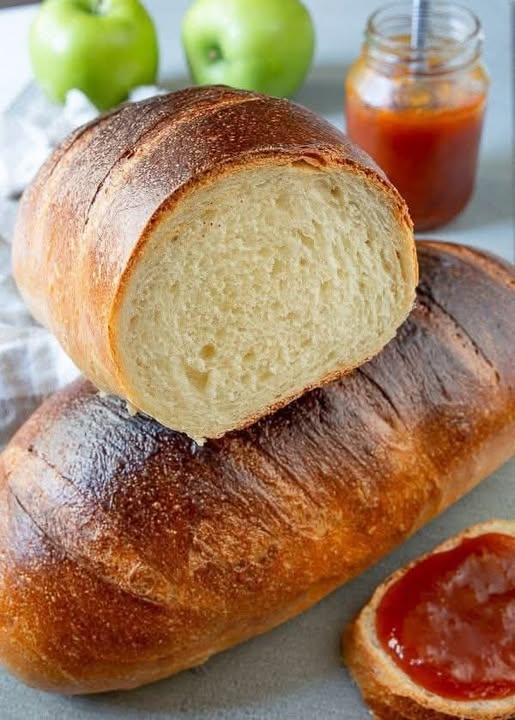ADVERTISEMENT
### Instructions for Making Homemade Bread:
#### 1. **Activate the Yeast:**
Start by activating the yeast. In a small bowl or measuring cup, mix the warm water with the sugar. Stir until the sugar dissolves, then sprinkle the active dry yeast over the top of the water. Allow the mixture to sit for 5-10 minutes. During this time, the yeast will begin to bubble and foam—this is how you know it’s active and ready to use.
#### 2. **Combine Dry Ingredients:**
While the yeast is activating, place the flour and salt in a large mixing bowl. Stir to combine. The salt will enhance the flavor and balance out the sweetness of the sugar, so make sure it’s evenly mixed in with the flour.
#### 3. **Add Wet Ingredients:**
Once the yeast has bubbled up and looks foamy, add the yeast mixture and olive oil (or melted butter) to the flour mixture. Stir with a wooden spoon or dough hook until a dough forms. The dough should be slightly sticky but manageable. If the dough feels too dry, add a tablespoon of water at a time until it comes together.
#### 4. **Knead the Dough:**
Turn the dough out onto a floured surface and knead for about 8-10 minutes. This process helps develop the gluten, which gives the bread its structure and chewy texture. Keep kneading until the dough is smooth, elastic, and slightly tacky to the touch. If the dough sticks too much, sprinkle it with a bit more flour, but be careful not to add too much.
#### 5. **Let the Dough Rise:**
Place the kneaded dough in a clean, lightly oiled bowl. Cover the bowl with a clean kitchen towel or plastic wrap. Allow the dough to rise in a warm place for about 1-2 hours, or until it has doubled in size. You can speed up this process by placing the bowl in a slightly warm oven (about 85°F or 30°C).
#### 6. **Shape the Dough:**
Once the dough has risen, punch it down to release any air bubbles. Turn it out onto a lightly floured surface and shape it into a loaf. You can either form a round boule (round loaf) or shape it into a rectangular loaf to fit a standard loaf pan. If using a loaf pan, lightly grease the pan before placing the dough inside.
#### 7. **Second Rise:**
Cover the shaped dough with a towel and let it rise again for about 30 minutes. This second rise allows the dough to expand further and results in a light, airy texture once baked.
#### 8. **Preheat the Oven:**
While the dough is rising, preheat your oven to **375°F (190°C)**. Place a rack in the center of the oven for the best air circulation while baking.
#### 9. **Bake the Bread:**
Once the dough has finished rising, place it in the preheated oven and bake for 25-30 minutes, or until the top is golden brown. You can test for doneness by tapping the bottom of the loaf—if it sounds hollow, it’s done! Alternatively, you can use a kitchen thermometer; the internal temperature should reach about **190°F (88°C)**.
#### 10. **Cool and Serve:**
Remove the bread from the oven and let it cool on a wire rack for at least 20 minutes before slicing. This helps the bread set properly and makes for cleaner, more even slices. Once it’s cooled enough to handle, slice it and enjoy!
### Variations and Tips:
– **Add-ins:** If you want to spice things up, feel free to add herbs (like rosemary or thyme), garlic, or even cheese to the dough before the first rise.
– **Sweet Variations:** For a slightly sweeter bread, add a bit of honey or cinnamon and sugar to the dough.
– **Whole Wheat Version:** You can swap half of the all-purpose flour for whole wheat flour for a heartier, more nutritious loaf.
– **Crispier Crust:** For a crispier crust, place a shallow pan of water in the bottom of the oven while baking. The steam will help create a crackly, golden crust.
– **Sourdough Option:** If you prefer sourdough, you can substitute the yeast with a sourdough starter and follow similar instructions.
### Why You’ll Love Homemade Bread:
– **Simplicity:** With just a few basic ingredients and minimal effort, you can create something truly special.
– **Customizability:** Homemade bread is so versatile. You can experiment with flavors, shapes, and toppings to suit your preferences.
– **Freshness and Warmth:** There’s nothing like the feeling of slicing into a freshly baked loaf while it’s still warm from the oven. The smell alone will make your kitchen feel like a comforting haven.
– **No Preservatives:** Making bread at home means you can avoid unnecessary preservatives and chemicals often found in store-bought varieties.
### Final Thoughts:
**Homemade bread** is a simple and satisfying pleasure that everyone can enjoy. With just a few ingredients and a little patience, you can create a delicious loaf that’s perfect for sandwiches, toast, or simply served with butter. The process of making your own bread connects you with an age-old tradition and offers a wonderful way to fill your home with warmth and comforting aromas. So roll up your sleeves, get your hands in the dough, and experience the joy of making bread from scratch.
ADVERTISEMENT
